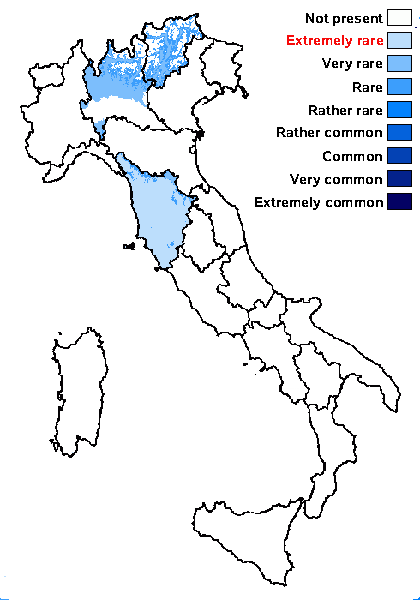Diplotomma lutosum A. Massal.
Miscell. Lichenol.: 41, 1856.
Synonyms: Buellia lutosa (A. Massal.) Anzi
Distribution: N - TAA (Nascimbene & al. 2022), Lomb. C - Tosc.
Description: Thallus crustose, episubstratic, rather thick, whitish to dirty yellowish brown, areolate, the areoles irregular in outline, flat to slightly convex, separated by deep cracks. Medulla white, I+ blue. Apothecia lecideine, black, 0.3-0.8(-1) mm across, subimmersed to subsessile, with a soon convex, usually epruinose disc, and a soon excluded proper margin. Proper exciple brown in outer part, paler within; epithecium brown; hymenium colourless, K/I+ blue; paraphyses simple, slightly capitate; hypothecium pale to dark brown. Asci 8-spored, clavate to cylindrical-clavate, the apical dome K/I+ dark blue with a pale, conical-pointed apical cushion (axial mass), the wall I-, but the thin outer gel I+ blue, approaching the Bacidia-type. Ascospores 3-septate, brown, ellipsoid, slightly curved and bean-shaped, 10-16 x 3-6 μm, with a minutely verrucose ornamentation more evident at both ends. Photobiont chlorococcoid. Spot tests: K-, C-, KC-, P-, UV-. Chemistry: without lichen substances.Note: an apparently widespread but rare, or at least rarely distinguished, silicicolous species characterised by ornamented, four-celled spores with transverse septa only, and by the I+ blue reaction of the medulla. It is very closely related to (and often synonymized with) the calcicolous D. dispersum, which differs in the less evidently ornamented spores and in the ecology.
Growth form: Crustose
Substrata: rocks
Photobiont: green algae other than Trentepohlia
Reproductive strategy: mainly sexual
Commonnes-rarity: (info)
Alpine belt: absent
Subalpine belt: absent
Oromediterranean belt: absent
Montane belt: rare
Submediterranean belt: very rare
Padanian area: absent
Humid submediterranean belt: extremely rare
Humid mediterranean belt: extremely rare
Dry mediterranean belt: absent

Predictive model
Herbarium samples
Growth form: Crustose
Substrata: rocks
Photobiont: green algae other than Trentepohlia
Reproductive strategy: mainly sexual
Commonnes-rarity: (info)
Alpine belt: absent
Subalpine belt: absent
Oromediterranean belt: absent
Montane belt: rare
Submediterranean belt: very rare
Padanian area: absent
Humid submediterranean belt: extremely rare
Humid mediterranean belt: extremely rare
Dry mediterranean belt: absent

Predictive model
| Herbarium samples |
 Index Fungorum
Index Fungorum
 GBIF
GBIF

